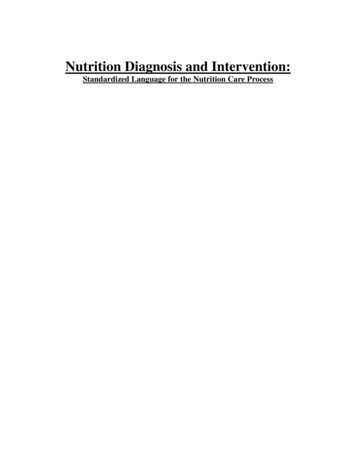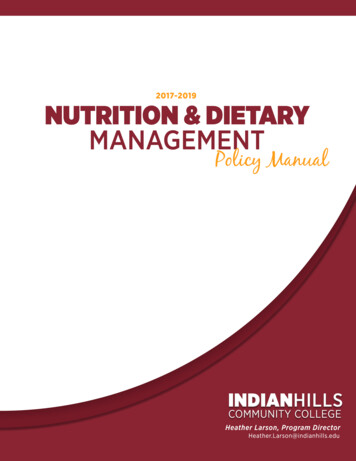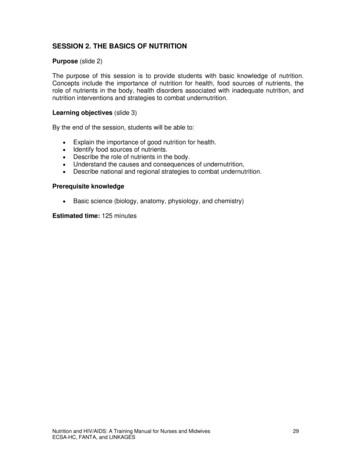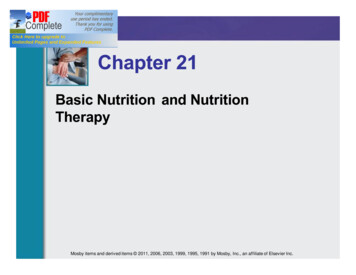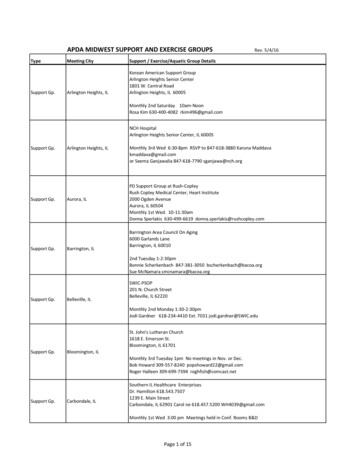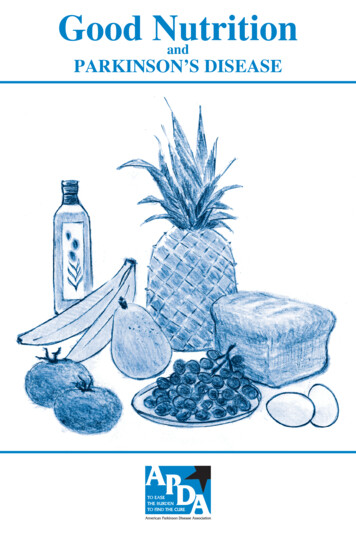
Transcription
Good NutritionandPARKINSON’S DISEASE
GOOD NUTRITIONandPARKINSON’S DISEASEJenny E. Loew MS, RD, CSN, LDNCarol Pratt, LDNAmerican Parkinson Disease Association, Inc.Copyright 2005Revised 2009
Jenny E Loew MS, RD, CSN, LDNJenny Loew is a registered dietitian specializing in, but not limited to, Parkinson’s disease. She has amaster’s degree in dietetics from Boston University and a certificate in sports nutrition from Simmon’sCollege. She has also obtained her accreditation as a registered dietitian from the American DieteticsAssociation and is licensed through the state of New Hampshire.Carol Pratt LPNCarol Pratt is a licensed dietician and nutritionist in the state of Massachusetts who is working as apart-time nutrition counselor, co-manages a support group for young onset Parkinson’s diseasepatients and is a consumer voting member for a health insurance company. She graduated in 1981from the University of Massachusetts, Amherst. She has worked for six years as a clinical nutritionistfor the Title III Nutrition Program. She also has 20 years of experience as a clinical nutritionist at a localhospital in the Boston area. She has been diagnosed with Parkinson’s disease.Reviewers:Marie Saint-Hilaire, MDCathi Thomas, RN, MSMichele Popadynec, RN, MPS
Table of ContentsIntroduction . . . . . . . . . . . . . . . . . . . . . . . . . . . . . . . . . . . . . . . . . . . . . .1Principles of Good Nutrition . . . . . . . . . . . . . . . . . . . . . . . . . . . . . . . . .2The Macronutrients That Make Up Our DietCarbohydrates . . . . . . . . . . . . . . . . . . . . . . . . . . . . . . . . . . . . . . . . .3Proteins . . . . . . . . . . . . . . . . . . . . . . . . . . . . . . . . . . . . . . . . . . . . . .4Fats . . . . . . . . . . . . . . . . . . . . . . . . . . . . . . . . . . . . . . . . . . . . . . . . .5Fiber . . . . . . . . . . . . . . . . . . . . . . . . . . . . . . . . . . . . . . . . . . . . . . . . . .7Vitamins . . . . . . . . . . . . . . . . . . . . . . . . . . . . . . . . . . . . . . . . . . . . . . . .8Vitamin D . . . . . . . . . . . . . . . . . . . . . . . . . . . . . . . . . . . . . . . . . . . . .8Vitamin C & E . . . . . . . . . . . . . . . . . . . . . . . . . . . . . . . . . . . . . . . . .9MineralsCalcium . . . . . . . . . . . . . . . . . . . . . . . . . . . . . . . . . . . . . . . . . . . . .10Iron . . . . . . . . . . . . . . . . . . . . . . . . . . . . . . . . . . . . . . . . . . . . . . . .11Coenzyme Q10 . . . . . . . . . . . . . . . . . . . . . . . . . . . . . . . . . . . . . . . . . .12Malnutrition in Parkinsonʼs Disease . . . . . . . . . . . . . . . . . . . . . . . . . .13Medications in Parkinsonʼs Disease . . . . . . . . . . . . . . . . . . . . . . . . . .147:1 Protein, Carbohydrate Ratio Diet . . . . . . . . . . . . . . . . . . . . . . . . .15How Can I Follow the Protein, Carbohydrate Ratio DietWithout Giving Up Taste? . . . . . . . . . . . . . . . . . . . . . . . . . . . .16Recipes . . . . . . . . . . . . . . . . . . . . . . . . . . . . . . . . . . . . . . . . . . . . . . . .17References . . . . . . . . . . . . . . . . . . . . . . . . . . . . . . . . . . . . . . . . . . . . .20
IntroductionParkinson’s disease (PD) is a neurological disorder which results from diminished levels of dopaminein the brain; resulting in tremors, rigidity, abnormal gait, and difficulty in motor function. In addition,patients with Parkinson’s disease may experience constipation, delayed stomach emptying,drug-nutrient interactions, and weight loss. Good nutrition is important for everyone and plays aparticularly critical role in Parkinson’s disease (PD). In general, a healthy diet can increase energy,maximize the potential of medications, and promote overall well-being.Parkinson’s disease affects the autonomic nervous system, resulting in slowed movement of the GItract. An individual may experience constipation and/or delayed gastric emptying. Gastric emptying maydelay or decrease effectiveness of medications. With adequate intake of fluids and fiber, constipationmay be prevented. Signs and symptoms of delayed gastric emptying should be observed whendetermining the timing of meals and medications.Some individuals, particularly those who experience fluctuations of PD symptoms with their medications, may be very sensitive to the amount of protein in their diets. For these individuals the timing ofmedications and meals/snacks containing protein becomes important. With the right amount ofprotein consumed at the proper intervals throughout the day, that is 30-60 minutes after medications,both optimal absorption of medications and protein needs are met.Parkinson’s disease symptoms such as tremor and the medication side-effect of dyskinesia mayincrease one’s caloric needs. When caloric needs are not met, the individual may experienceunintentional weight loss and even malnutrition in prolonged circumstances of a low calorie intake.You may have questions about certain vitamins and/or minerals and whether you could benefit fromany supplements. Adequate intake of vitamins and minerals is important for many bodily functions.Although vitamin and mineral deficiencies are rare in the United States, many individuals do not meetthe recommended daily allowance; however, each individual’s diet varies greatly, so you should firstconsult your doctor or dietitian before taking any supplements.This booklet is intended to introduce to patients and caregivers helpful nutrition information relevant toParkinson’s disease. Further information can be obtained from your doctor or dietitian.1
1. Use the Food Guide Pyramid to structure your eating habits. Choose a wide variety offoods from all the food groups. At each meal try to consume a portion from at least three ofthe food groups.2. Limit your total fat, saturated fat, and cholesterol. You can accomplish this by choosinglean meats, cheeses, and dairy products. Trim the visible fat off your meat. Grill, broil, or bakemeat rather than frying. Choose 1 percent butterfat or less milk and milk products. Limit totalfat to 30 percent of your daily calories.3. Limit your salt or sodium. You can achieve this by choosing more fresh or frozen foods andlimiting processed foods. Go easy on condiments such as olives, ketchup, mustard, pickles,and soy sauce. Read food labels and choose foods that have a sodium content of 5 percentor less of the daily value per serving. Eat plenty of fruits and vegetables, which are naturallylow in salt. Please note that if you have hypotension, you may be asked to increase your saltintake under a doctor’s supervision.4. If you drink alcohol, do so only in moderation. Alcohol supplies moderate amounts of calories and few nutrients. Limit intake to one drink per day for women or two drinks per day formen. One drink is 12 oz of regular beer, 5 oz of wine, or 1.5 oz of distilled spirits.5. Choose a diet high in fiber. A high-fiber diet may protect against many chronic diseases.You can accomplish this by selecting whole grains, minimally processed foods, fruits and vegetables.2
The Macronutrients That Make Up Our DietCarbohydratesWhat is the role of carbohydrates in the diet?Carbohydrates are sugars and starches, and they are the main energy source for the body. Onegram of carbohydrates provides 4 calories. They are found in fruits, breads and cereals, milkproducts, and vegetables. They are also found in most desserts, candy, and sweetened foods.Are there “good” and “bad” carbohydrates?Complex carbohydrates are considered to be the “good” carbohydrates. These are found infoods that are less refined and closer to their natural state. Good sources include foods madewith whole grains, brown rice, and fresh fruits and vegetables. Because these foods are lessrefined, they are usually good sources of vitamins, minerals, and fiber, also. They are brokendown slowly in the digestive tract, and gradually enter the bloodstream. By comparison, themore refined, or simple carbohydrates are broken down quickly and can cause a rapid rise inyour blood sugar, which can be followed by a drop in blood sugar.Are there special considerations for Parkinson’s disease?Dietary carbohydrates play a role in the absorption of Levodopa by triggering a release of insulinwhich lowers the blood levels of large neutral amino acids. Lower levels of large neutral aminoacids in the blood may enhance the delivery of Levodopa to the brain (see the protein section).It is recommended that 55 to 60 percent of the calories in your diet come from carbohydrates.3
ProteinsWhat is the role of proteins in the diet?Proteins are combinations of amino acids that build, repair, and maintain all of your body’s tissues. Dietary proteins are broken down into amino acids in the stomach and intestine and thenabsorbed into the blood, where they become the “building blocks” for new proteins. Your bodymakes nonessential amino acids, while others are considered “essential” because your bodycannot make them. Essential amino acids need to be obtained through the diet. Eating a variety of foods, including good sources of protein in amounts to meet your needs, will give you thefull variety of amino acids.If you don’t consume enough carbohydrates and fats, tissue proteins can be broken down intoamino acids and used by the body for energy instead of maintenance. When you consumemore protein than you need, the protein is broken down and stored as body fat. Protein provides 4 calories per gram.Where are proteins found?Good sources of protein include foods from animal and plant sources. Animal sources includemeat, poultry, fish, eggs, milk, and cheese. Plant sources include legumes (lentils, dry beansand peas), seeds, nuts, breads, and cereals.How much protein do we need?The average American diet is much higher in protein than is actually needed. The recommended daily allowance for protein is 0.8 grams per kilogram of body weight. This would be 62 gramsof protein for a 77 kilogram (170 pound) man, and 52 grams of protein for a 65 kilogram (143pound) woman.Calculating protein requirements:1 pound 0.45 kilogramweight in pounds divided by 2.2 weight in kilograms (kg)weight in kg multiplied by 0.8 protein needs in grams (g)Example:(170 pounds)/(2.2) 77 kg77kg x 0.8g 62g62 grams of protein are needed daily.For optimum health, all people with Parkinson’s disease need a minimum of 0.8g protein per kgbody weight per day. Protein deficiency, caused by restricting your protein intake to less thanwhat your body needs, can result in weight loss, muscle wasting, slow wound healing, skin andblood changes, and reduced resistance to disease. In addition, it should be noted that the RDAis calculated for healthy people, and it may need to be modified in illness, although higheramounts of protein have been found to interfere with Sinemet in some people with Parkinson’sdisease. (See the recommendations in the section “7:1” diet.)4
What is the role of fats in the diet?FatsFats are complex substances made up of combinations of fatty acids. Like proteins and carbohydrates, fats supply energy in the form of calories. They are a concentrated source of energy,providing 9 calories per gram.Although a diet high in fat has been linked to many chronic health problems, such as heart disease, some types of cancer, and obesity, fats have some positive health benefits.In the first place, fats help to support the work of other nutrients in your body. The fat-solublevitamins A, D, E and K wouldn’t be effective without dietary fats to dissolve them and providetransport in the bloodstream.Are fats necessary for health?Linoleic acid and alpha-linolenic acid are fatty acids (the “building blocks” of fat) that are considered essential because they can’t be made by the body and have to be obtained through thediet. Alpha-linolenic acid converts to omega-3 fatty acids, which help to keep your brain andnervous system healthy. Linoleic acid is an omega-6 fatty acid. Both may promote heart healthby lowering total and LDL cholesterol.Both of these essential fatty acids are easily available to the body in a varied diet. Fatty fish,soy, flaxseed, canola, nuts, and seeds are good sources of omega-3 fatty acids. Soy, corn, andsafflower oil are good sources of omega-6 fatty acids.Are there “good” and “bad” types of fat?Foods are not made up of a single type of fat, but we are concerned with the type that makesup the largest percentage of the fat content.Polyunsaturated and monounsaturated fats are considered “good fats.” Rich sources ofmonounsaturated fats are canola, nut and olive oils. They help to lower total and LDL cholesterol (the “bad” cholesterol), and may raise HDL (the “good” cholesterol) levels. Polyunsaturatedfats are found in corn, safflower, soybean, sesame, and sunflower oils, and are the predominantfat found in seafood. They also assist in lowering total and LDL cholesterol, along with loweringHDL.Saturated fats are usually referred to as “bad fats.” They are found mainly in animal-basedfoods like meat, poultry, whole milk, and butter, and in palm and coconut oil. They can raise totaland LDL cholesterol levels by triggering the liver to increase production of cholesterol.Trans fatty acids are also considered to be “bad fats.” They are found mainly in hydrogenatedfats (vegetable oils that have been processed to become solid at room temperature). They actlike saturated fats in the body.Are there “good” and “bad” types of cholesterol?Cholesterol is not actually a fat, but a fat-like substance. It’s found in every cell in in the body,and it’s found in some hormones. Only found in foods of animal origin, cholesterol is sometimes5
confused with saturated fat because they often appear together. Dietary cholesterol is found infood, and serum cholesterol is found in your bloodstream. The cholesterol circulating in yourbody comes from two sources. It is produced in the liver, and it comes from foods in your dietthat contain cholesterol. A diet high in cholesterol can negatively affect serum cholesterol levelsin some people, but the amount and type of fat in your diet has a much greater effect on yourhealth.The terms “good” and “bad” cholesterol refer to the cholesterol carried in your bloodstream.HDL (high-density lipoprotein) is known also as “good” cholesterol. High HDL levels decreaseheart-disease risk, while LDL (low-density lipoprotein) levels, if high, increase the risk of heartdisease.What are the recommendations for fat use in Parkinson’s disease?Fat intake should be no more than 30 percent of your total calories, with an emphasis on fewersaturated fats. Fat takes longer to leave the stomach than carbohydrate or protein; therefore,it’s best to avoid large, high-fat meals if you’re taking Sinemet because it can decrease theeffectiveness of the medication by delaying gastric emptying.6
FiberWhat is fiber, and what is its role in the diet?Fiber is the indigestible part of a food of plant origin. It can’t be used by the body for energy, butis still necessary for good health by helping to promote regular bowel movements.Are there different types of fiber?Dietary fiber can be soluble or insoluble. Both types of fiber have significant health benefits, butthey work in different ways.Insoluble fiber helps to prevent constipation by adding bulk and softness to stools. Adequatefluid intake is necessary, since insoluble fiber works by absorbing fluid. Good sources of insoluble fiber are whole wheat products including wheat bran, vegetables, fruit, flaxseeds, andlegumes.Soluble fiber helps to lower blood cholesterol levels, and regulate blood sugars. Good sourcesof soluble fiber are legumes, oats and oat bran, barley, flaxseeds, and many fruits and vegetables.What is the role of fiber in Parkinson’s disease?Constipation is a common problem in Parkinson’s disease. It can be caused by medications,decreased fluid intake, or the condition itself. The nerves controlling the gastrointestinal tractcan be affected by PD, causing increased intestinal content transit time. Dietary fiber is veryimportant in the management of constipation. To ensure adequate fiber intake, try to eat at leastfive servings of fruits and vegetables each day, and choose whole grains over refined foods. Inaddition, try to drink 6 to 8 cups of fluid each day, preferably noncaffeinated.7
VitaminsVitamins are organic compounds necessary for life, although they do not, independently, provide energy. Vitamins are essential to many bodily functions, including growth, metabolism,blood clotting, preventing diseases, body growth and maintenance, immune function, andmany more. Although vitamin deficiencies are rarer in the United States than in many developing countries, it is still important to eat a wide range of foods to meet the recommendeddaily allowance for each vitamin.Vitamin DWhat is the role of Vitamin D in the diet?Vitamin D promotes the absorption of two minerals - calcium and phosphorus - and regulates thecalcium levels in the blood. It also helps in depositing these minerals in your bones and teeth,making them stronger. Fortified foods such as milk and specially fortified orange juice are commonsources of Vitamin D. Milk products such as cheese and ice cream are generally not fortified withVitamin D. Sunshine is a significant source of Vitamin D because your body makes Vitamin D fromUV light touching your skin.What are the dietary recommendations for Vitamin D?The RDA for adults is 400 IU per day, and 600 IU by the age of 70. The increased amount for olderadults is due to the fact that as we age, our skin isn’t able to produce as much Vitamin D. If you donot go outdoors, you cover up, or use a sunscreen, you need to pay special attention to gettingVitamin D from fortified foods or consider taking a supplement. One cup of Vitamin D fortified milkcontains 100 IU.8
Vitamin C & EVitamin C, or ascorbic acid, and Vitamin E have antioxidant properties and were once speculated to be protective against the progression of PD. Theoretically, free radicals are producedby metabolic processes in the brain and they can damage nerve cells, including dopaminogeniccells. Antioxidants are known to break down free radicals or prevent their formation. Studies,however, do not show any significant benefit of consuming more than the recommended dietaryallowance (RDA) for Vitamin C and E for people with PD.Vitamin C is important for wound healing, absorption of iron, increasing resistance to infection,and the synthesis of neurotransmitters. Good sources of Vitamin C are citrus fruits, broccoli,brussel sprouts, green peppers, strawberries, cauliflower, cabbage, tomato, cantaloupe, andspinach. The RDA for Vitamin C for an adult is 60mg per day. This is equal to approximately 1/2cup of orange juice or 1 cup of cantaloupe.Along with its powerful antioxidant capabilities, Vitamin E is also important in energy and cellmetabolism. The RDA for Vitamin E for adult males is 10mg and 8mg for females. This is equalto approximately 1.5 oz. almonds or 3 tablespoons of corn oil. Other good sources of Vitamin Eare vegetable oils, wheat germ, spinach, collards, nuts, and dried beans.As you may have noticed both Vitamin C and E are easily consumed in the diet in the recommended amounts per day; therefore, supplementation in mega doses is not warranted.Depending on your individual diet, a multi-vitamin formulation or supplement may be beneficial.Please consult your doctor or dietitian for further information.9
MineralsMinerals are inorganic substances essential to life. Along with vitamins and water, minerals helpregulate the various body processes such as circulation, respiration, digestion, and elimination.Minerals are found in water and in natural foods but are used to fortify some processed foods.Mineral toxicity is possible but unlikely if you are not taking megadoses of a mineral over a periodof time. Mineral deficiencies are also possible but not common if you are eating a wide variety offoods from all five food groups.CalciumWhat is the role of calcium in nutrition?Calcium builds bones, and helps them to remain strong, by slowing the rate of bone loss as youage. It also assists in muscle contraction, promotes normal nerve function, and helps yourblood clot if you’re bleeding. Milk and milk products such as yogurt and cheese are excellentsources of calcium. In addition, some dark green leafy vegetables (kale, broccoli, bok choy),canned salmon and sardines with bones, calcium-fortified soy milk and orange juice, and tofumade with calcium sulfate are good sources.What are the dietary recommendations for calcium intake?The RDA for adults is 800 IU until age 50, when it is increased to 1200 IU. People with Parkinson’sdisease have an increased risk of bone loss, and should be sure their diet isn’t deficient in calcium. If you find it hard to get enough calcium in your diet, you may want to consider a supplement.Calcium carbonate is the most commonly used supplement; however, it reduces stomach acid,which can interfere with nutrient absorption. It can also be constipating for some people. Calciumcitrate is a better choice; it doesn’t affect stomach acidity, and it isn’t constipating.Excellent sources of calcium:(approximately 300mg per serving)1 cup of low fat milk1 cup of yogurt1 1/2 ounce of hard cheese1 1/4 cup cottage cheese1 to 2 cups of cooked dark green, leafy vegetables2 cups of cooked broccoli10
What is the role of iron in the diet?IronIron forms part of hemoglobin, the molecule that enables your red blood cells to transport oxygenthroughout the body. It also helps the immune and central nervous systems and aids in energyproduction.What are the dietary recommendations for iron?The body is very efficient at storing and reusing iron, and stored levels tend to increase withage; however, iron deficiency can be a problem for younger women because of blood loss frommenstruation and for older people because of a poor diet. A suspected deficiency should alwaysbe evaluated by your healthcare provider before taking supplements because excess iron canbe harmful. The RDA for iron for adult women is 10 mg and 15 mg for adult men. Meat, poultry,and fish are excellent sources of iron. Fortified grain products, like cereals and breads, legumes(especially soybeans), nuts, and vegetables also provide iron in the diet. Foods that are high inVitamin C, such as strawberries, broccoli, or citrus fruits, enhance iron absorption.Are there special considerations for people with Parkinson’s disease?Iron supplements can interfere with Levodopa absorption, so they should be taken separately,although the small amount of iron in a standard multivitamin preparation shouldn’t be a problem.11
Coenzyme Q10What is Coenzyme Q10?Coenzyme Q10, or ubiquinone, or CoQ10 for short, is a naturally occurring compound producedin the heart, liver, kidneys, and pancreas. CoQ10 is used by the body for energy production andas a powerful anti-oxidant. The amount of CoQ10 produced by the body declines with age, heartdisease, and with some medications -i.e., statins, some diabetes drugs, and perhapscoumadin. CoQ10 is present in food in small amounts, primarily in organ meat, chicken, beef, soy oil, sardines, mackerel, and peanuts. Because CoQ10 is only in food in scarceamounts, it is commonly consumed in an oral supplement form.Is there a link between CoQ10 and PD?Oral CoQ10 supplementation has been used to treat heart failure because of its role in energyproduction. It may also be beneficial in treating a number of other diseases as well asParkinson’s disease due to its antioxidant effects. A theory is that it protects cells from damagecaused by PD. Research suggests a positive trend for CoQ10 and the slowing of the progression of the disease with little side effects. To date, studies have demonstrated that a dose of1,200 mg per day may have the most benefit in PD patients; however, CoQ10 recommendations are premature at this time and further research is warranted. Should you be taking anysupplements? Please consult your doctor beforehand.12
Malnutrition in Parkinson’s DiseaseAre you at an increased risk?As we age and become elderly, we are all at an increased risk for malnutrition. With age, oursensitivity to the four basic tastes of sweet, sour, salty, and bitter decreases. It is common to beon medication which may cause anorexia. Poor oral health may make it difficult or painful to eat.Chronic disease and motility problems may also increase the risk of malnutrition. Depression orloneliness are common causes of a decrease in appetite. Other socioeconomic influences affecting food choices and malnutrition include income, education, age, gender, daily schedule, andaccess to food stores.Malnutrition in PDSince PD is seen more often in the elderly, it poses an even greater risk for the development ofmalnutrition. PD may cause difficulty chewing and swallowing, bradykinesia (slowness in movement), dyskinesia (involuntary movements) and increased calorie needs all of which may causeweight loss and/or malnutrition. Antiparkinsonism medications can also cause nausea, vomiting,loss of appetite, constipation, hallucinations, and confusion. Nausea and loss of appetite usuallysubside a few weeks after starting medication, but not always completely. Malnutrition occurswhen long-term eating habits are inadequate.How do I know if I am malnourished?Body weight is a good indicator of nutritional status. A weight loss classified as significant is a signof undernutrition and should be evaluated. Please refer to the calculation and chart below to determine if your weight loss is classified as significant.1. Calculation of Percent Weight Change% weight change (usual weight – current weight) X100usual weight2. Assessment of Weight Change.TIME FRAME1 WEEK1 MONTH3 MONTHS6 MONTHSSIGNIFICANT WT LOSSGreater than or equal to 1-2%Greater than or equal to 5%Greater than or equal to 7.5%Greater than or equal to 10%How can I avoid unintentional weight loss?If you have difficulty chewing or swallowing, take your time while eating. Eat five to six smallermeals per day rather than two or three large meals. A heating tray may be useful to keep foodwarm longer. Choose calorie-dense, nutritious foods. A milk shake or supplement shake maybe useful between meals to help meet calorie needs. There are support groups and servicesavailable for seniors. Most importantly, consult with your doctor and dietitian if you have concernsabout weight loss or gain.13
Medications in Parkinson’s DiseaseThe primary drug used in the treatment of Parkinson’s disease is Levodopa. There are severaldiet components that interfere with the absorption and thus, ultimately, with the effectiveness ofthis medication.Protein and Levodopa interactionCompounds called amino acids make up dietary protein. Levodopa is structurally similar to certain amino acids (large neutral amino acids, or LNAAs), and they compete for the same transportsystem across the blood-brain barrier. Levodopa must arrive at its destination in the brain to beconverted to dopamine, and this competition can decrease the amount of Levodopa reachingthe brain. Some people with Parkinson’s disease are not affected by protein in the diet, butothers notice a reduced effectiveness of Levodopa when it is taken too close to meals. Also,some people find that the proteins in milk and milk products block the Levodopa absorption toa greater extent than other proteins.Gastric EmptyingBefore it can reach the transport mechanism at the blood-brain barrier, Levodopa must reachthe small intestine for absorption. Food in the stomach can slow the progress of the Levodopaby delaying the emptying of stomach contents into the small intestine. The longer Levodoparemains in the stomach, the more vulnerable it is to enzymes that prematurely convert it todopamine, which is ineffective if not produced in the brain. Once in the small intestine, theLevodopa must compete with any LNAAs present for absorption into the bloodstream. Also,Levodopa has a very short plasma half-life, which means that it will start to disappear from theblood in 60 to 90 minutes. Therefore, it needs to reach the brain before this occurs.Parkinson’s disease can affect the nerves of the GI tract causing delayed gastric emptying. Ifyou experience symptoms of bloating, delayed uptake of medications, quick fulfillment after eating, or gastroesophageal reflux, consult your doctor or dietitian for helpful hints and/or medicationchanges.Timing of MedicationFor the reasons previously mentioned, Levodopa should be taken at least 30 minutes prior tomeals, except in cases where the drug produces nausea, or if there is an excess of dyskinesiaafter taking Levodopa. For nausea, which is common during the early adjustment to Levodopa,it should be taken with a light, low-protein snack. For dyskinesia, take with a small, high-proteinsnack.If fluctuations, or on/off effects are still a problem, the amount and distribution of protein in thediet should be taken into account, as in the 7:1 diet on the next page.14
The 7:1 Carbohydrate to Protein DietWhat is the 7:1 diet, and how is it planned?The 7:1 diet balances carbohydrate and protein, allowing for 7 parts carbohydrate for 1 part protein. Each meal and snack is planned in this ratio for best results. The total grams of protein tobe eaten at each meal are calculated. This can be done by reading the food labels or consulting lists of protein content of foods. Based on the amount of protein at each meal, the grams ofcarbohydrate that should be eaten are calculated. For example, if 10 grams of protein is included at breakfast, 7 times that amount (7x10) or 70 grams of carbohydrate should be included atbreakfast as well.Planning the 7:1 dietDetermine protein need (0.8g x wt. in kgs)Example: 170 pound male (170 divided by 2.2 77kg) x 0.8g 62g protein (248 calories fromprotein)Multiply by 7Example: 7 x 62g protein 434g carbohydrate x 4 calories per gr
intake under a doctor’s supervision. 4. If you drink alcohol, do so only in moderation.Alcohol supplies moderate amounts of calo-ries and few nutrients. Limit intake to one drink per day for women or two drinks per day for men. One drink is 12 oz of regul


